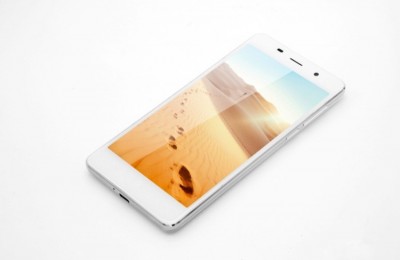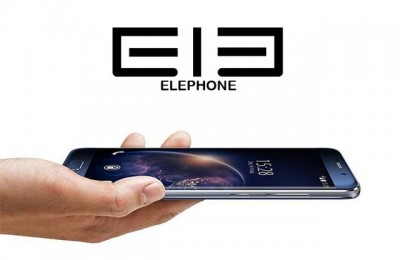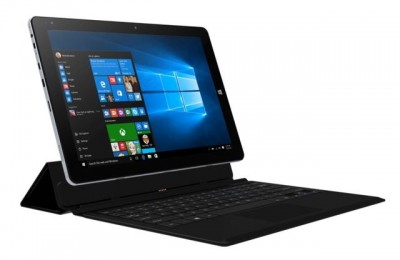Ultrabook transformer. Dell Latitude 13 7350 worth very expensive, but also offers a lot – the focus of a new efficient processor Intel Core M and expected thanks to him, a long battery life.
Hybrid Tablet level of our Dell Latitude 13, 7350 – a tool for work, study, and multimedia playback. They are expected to be in high speed, image quality, a lot of communication and interfaces, and long battery life. Latitude 7350 is based on the efficient processor Intel Core M, created specifically for such devices, and uses the SSD-drive, so that speed can be no doubt. Full HD IPS-screen promises a clear and vivid picture, and the presence of the battery in the tablet itself, and in the dock – a decent time. We verify whether our expectations are met.
Design and Build Quality
And the tablet and the keyboard is made quite accurately. Parts fit tightly, wide gaps not. We were pleasantly surprised by the resistance to bending of the keyboard: it is usually in such devices much lower. The pen tablet with some effort, you can bend, but only slightly. Pressure plate can not be, but around the keyboard is vulnerable to this type of deformation plots still available. We believe that for the price Dell should not skimp and use aluminum for all parts of the body, not just the bottom of the keyboard and the back of the tablet.
By design, Latitude 13 is the best suited definition of “low-key”. The device is not that ugly, but its original appearance can not be named. Matte black and glossy surface of the screen look very boring – we hope that the functionality of the tablet will allow not pay attention to it.
Loop docking station allows maximum opening angle of about 120 degrees, which is pretty reasonable – even a little, and the plate is simply to outweighed the keyboard, making the design tip “on the back.” At least a predetermined angle hinges hold confidently even too – open the screen with one hand will not work.
Unlike many competing tablets and hybrids, Latitude 13 readily provides access to its internal components. Just remove the back of the tablet, not even secured with screws instead they use plastic clip, so you should be patient and proceed with caution. No fan, as efficient processor Intel Core M passively cooled, but there are a few components that can be replaced if desired. This keeps the battery a few screws, BIOS-battery, SSD-drive format M.2, wireless (Wi-Fi / Bluetooth) module and one free slot M.2, designed for 3G or 4G / LTE modem. Necessary for its operation of the antenna are built so that you can independently adjust independently bought a modem or buy a little more expensive configuration with integrated LTE-modem from Dell (Wireless 5810e). The only thing missing – a memory in the form of a standard removable module SO-DIMM instead of soldered on the motherboard chips, but here everything is clear: SODIMM-slot design thickens considerably, and a place for it was not. The rest of the Dell deserves praise – to contact the service center for elementary operations such as installing a larger capacity SSD or replacement battery is not required.
Interfaces
Hybrids of this level usually offer a variety of ports, but their usefulness is highly dependent on their location. Unfortunately, in our Latitude 13 all the main interfaces (2 USB 3.0 ports, and video output mini-DisplayPort) are located behind the keyboard dock, but not on the tablet. This means that the last few lighter and thinner than competitors like HP Envy x2 13, but, unlike them, can not be connected to an external monitor or USB-periphery in the absence of a docking station (forgotten, for example, at home or at work). Even the SD-card reader located on the docking station. On the tablet, there is only a 3.5-mm audio jack.
To connect to a wired Ethernet network adapter needed for USB (3.0 necessarily, if you want to gigabit speed) for image display, devoid DisplayPort – adapter with him to VGA, or HDMI. None of this is not supplied.
Communication
In our configuration, set the wireless module Intel Wireless-AC 7265, which allows to work with Bluetooth 4.0 and networks Wi-Fi 802.11 a / b / g / n / ac in the range of 2.4 and 5 GHz. It works well within a radius of 15 meters from the router connection to remain stable and fast – on most apartments and offices that would be enough, but if you have a sufficiently powerful router can certainly move away and away. There is support for Wi-Di – we have not tested it, but all the necessary components – the processor, video card and Wi-Fi module from Intel – are available. In addition, the tablet can work with NFC.
Module 3G or 4G in our sample Latitude 13 not, but, as mentioned above, it is possible to put on their own or with a pre-selected configuration (Dell Wireless 5810e). This will provide an opportunity to access the Internet anywhere where there is a signal of your mobile operator.
Dynamics
The dynamics of the tablet were surprisingly good: they give a rich, crisp sound, allowing even listen to music. Lacks bass, but in this case it is not very exciting.
Camera
The front camera takes pictures at resolutions up to 2 megapixels and provides acceptable for Skype-quality video calls. Rear 8-megapixel camera, but for normal photos must almost studio lighting, otherwise they go dull and grainy. Outdoors photo obtained good – to remove anything in the country is quite possible, in the room, the situation is much worse. Below the pictures of both cameras is clearly not enough brightness in comparison with our camera made by Canon.
input Devices
We enjoyed typing on Latitude 13: return typing pleasant keystroke average, and their slightly concave shape reduces the amount of typing errors, as well as a reasonable size of the keys and the spaces between them. The keyboard is also equipped with a two-level backlight, allowing to work in the dark.
Established klikpad boasts large enough (10.6 by 6.1 cm) square and moderately slippery surface, well suited for multi-touch gestures. Clicking on the surface klikpada does not require special efforts and significantly well as tactile and acoustically (audible click is heard well).
Of course, touch input. Recognizes up to 10 simultaneous touches, the sensitivity of the screen is uniform up to the edges of it. Anyone can get a brand stylus from Dell, enables precise handwriting or drawing.
Screen
The screen is one of the strengths of Latitude 13. Resolution 1920 x 1080 pixels provides a very clear picture on the 13.3-inch diagonal, but will have to put a high zoom settings in Windows, otherwise all the icons and menu items will be tiny. However, even when properly configured, some scaling is not adapted to the high density of the points of application will not be displayed correctly: a list of issues may include the above menu items are tiny, fuzzy fonts or do not fit in their allotted place labels. Be blamed for this, of course, the developers of such applications, not “too high” resolution. Anyway, in all major applications (MS Office, browsers, system applications like music player) All items are displayed normally.
Screen brightness reaches an average of 339 cd / m², which allows to use the tablet on the street, go into the shadows are not necessarily – in any case, by avoiding direct sunlight. The distribution of illumination, however, could be better: at maximum brightness difference between the center of the screen and its bottom is about 60 cd / m², that if you look closely, is expressed in the non-uniform illumination of the image.
Black level is very low (0.27 cd / m²), which provides a deep, nice black color without a hint of gray tide. The maximum contrast ratio was 1374: 1, the screen displays the Latitude 13 rich, saturated picture and nice to work with him.
Part of our measuring equipment has refused to work with Latitude 13, so measure the coating color sRGB and AdobeRGB spectra we could not. But most of all, to engage in professional work with graphics on the device, no one will, therefore these figures are not very important. Color accuracy, however, managed to define: it is quite good, especially when it comes to colors. Shades of gray are less accurate, but their deviation from the norm is not too large. So in terms of the reliability of colors displayed on the Latitude 13 is quite possible to rely on.
IPS-matrix allows you to view the screen from any position, not noticing any distortion or decrease brightness. Given that the screen is glossy, it’s very useful – you can turn it to the plate so that the light source does not cause glare, and keep working without looking at the inverted color, as is usually the case for TN-matrices.
Performance
Inside the tablet hiding efficient processor Intel Core M-5Y10 with integrated graphics Intel HD Graphics 5300, 4GB soldered to the motherboard and RAM SSD type M.2 capacity of 256 GB. Let us consider each component in detail.
Processor and memory
Intel Core M-5Y10 – sverhnizkovoltny (TDP 4.5 W) to the new processor 14 nm architecture Broadwell, capable of using a wide range of operating frequencies (800 MHz to 2 GHz). It depends on the load and cooling; Recently, in our case, the passive, so we’re not surprised that in the Cinebench benchmark using multithreading (4 streams: two physical cores are complemented by technology to support Hyper-Threading) the frequency did not exceed 1.3-1.4 GHz. However, in the single-threaded tasks it has reached the stated 2 GHz, allowing the processor to compete with low-voltage (15 W) Core i3 / i5 previous generation, Haswell. All this is fully consistent with the plan of Intel: for short loads Core M is able to deliver a relatively high speed, with the long preferred energy saving and heat retention within the prescribed limits. This means that the Core M fully able to cope with viewing multimedia, office applications, browser and simple photo editing, while not spending too much battery power, but it is not suitable for serious gaming, 3D-modeling or other challenges.
The RAM is 4 GB, which should be enough for any task with which the processor is able to cope. It operates in dual channel mode, which is slightly (10-20%) increases the speed of execution of dependent tasks (for example, the work built into the CPU card).
Drive
Installed SSD manufactured by Toshiba, and, despite its high-speed interface M.2, performance of miracles is not revealed. It is about on par with middle-class SSD bus SATA, but this is more than enough for the system to start up instantly and responded to any team. If you 256GB is not enough, you can install any other SSD more, should go for any model M.2 slot format in 2280 (22 to 80 mm, the most common among SSD M.2 for size). Despite the presence of a recovery partition on the OEM SSD, included also found the flash drive to restore the system from which you can reinstall the operating system (64-bit Windows 8.1) on any new SSD in the plate. A pleasant surprise was its compliance with USB 3.0: this will reinstall Windows much faster than if its speed was limited to a maximum long been outdated USB 2.0.
Video card
The video card Intel HD Graphics 5300, despite his support for DirectX 11.2, for games not designed and allows you to run a two-dimensional game of the Windows Store, or old and undemanding. If you are able to move gameplay with frame rates of 25-30 per second, you can run and some modern games like Tomb Raider on the most minimal settings and a resolution of 1024 by 768 pixels. As for the movies, then this all integrated Intel video card for several years to cope well, allowing you to watch at least Full HD video with very high bitrate without slowdown and binding.
Stress test
Although passive cooling Latitude 13 maximum temperature at full load does not exceed 38 ° C, and then only at one site: all others remained within 30-35 ° C. At idle or low load maximum heating is 31 ° C.
Stress test explains such a low heat: For prolonged high load on the processor and a built-in video card processor is subject to strict throttling (up to 500 MHz). In normal use, such a load plate reproduce fail, and therefore the processor will run at least at its base frequency (800 MHz), and if necessary to use Turbo-mode (as mentioned above, up to 2 GHz).
Cost-effective platform Core M consumes 4.3 to 9.1 watts when idle and only 14-16 watts at high load. Given that the last state tablet a lot of time will not, you can expect quite a long battery life.
In addition to the built-in tablet battery 30 Vt⋅ch, there is also an additional 20 Vt⋅ch installed in the keyboard dock. This is enough for almost 5 hours average load at maximum brightness (for example, playing the game of the Windows Store), 8:00 viewing Full HD movies or slightly less than 9 hours of Internet surfing on Wi-Fi. Read the book on the minimum brightness can be 15-16 hours. Without the use of a docking station, all these results should be reduced by 40%, which means 3:00 loads 5:00 1080p video, 5 and a half hours Wi-Fi and 9 and a half hours of reading. It’s still very good results for the tablet (If the keyboard disconnected, Latitude 13 is just them) with the high-quality screen and powerful processor.
Verdict

Dell has created a high-quality and fast hybrid tablet with which to work with. High contrast and bright screen and fast SSD – these are the things without which use modern laptop or tablet unpleasant. However, it’s all there in the HP Envy x2 13 – though in Russia it has not. Therefore, in the absence of Latitude 13 7350 can be recommended to buy, if you need just such a tablet-convertible and you are willing to pay 90 thousand rubles. But as soon as we come to the Envy x2 13, it will have to buy it, and not the product Dell: he loses only the total battery capacity (no second in the dock, and one in the tablet, the same) and the impossibility of disassembly, but it is much cheaper and not inferior in quality or performance of the screen, and all the ports in it are located on the tablet, allowing you to leave the dock at home. Another option – Yoga 3 Pro from Lenovo, can not completely remove the tablet part, but equipped with a 360-degree loop.
If you do not want to turn a laptop into a tablet, it is better for the money to buy advanced ultrabook from Asus (Zenbook), Apple (MacBook Air), Acer (Aspire S7) or other companies. Then it is better to wait: is about to come out with new versions of their processors Broadwell-U and possibly ports USB Type C and support WiGig.
Read another very interesting article about alternative energy of the Sun, water and air.





